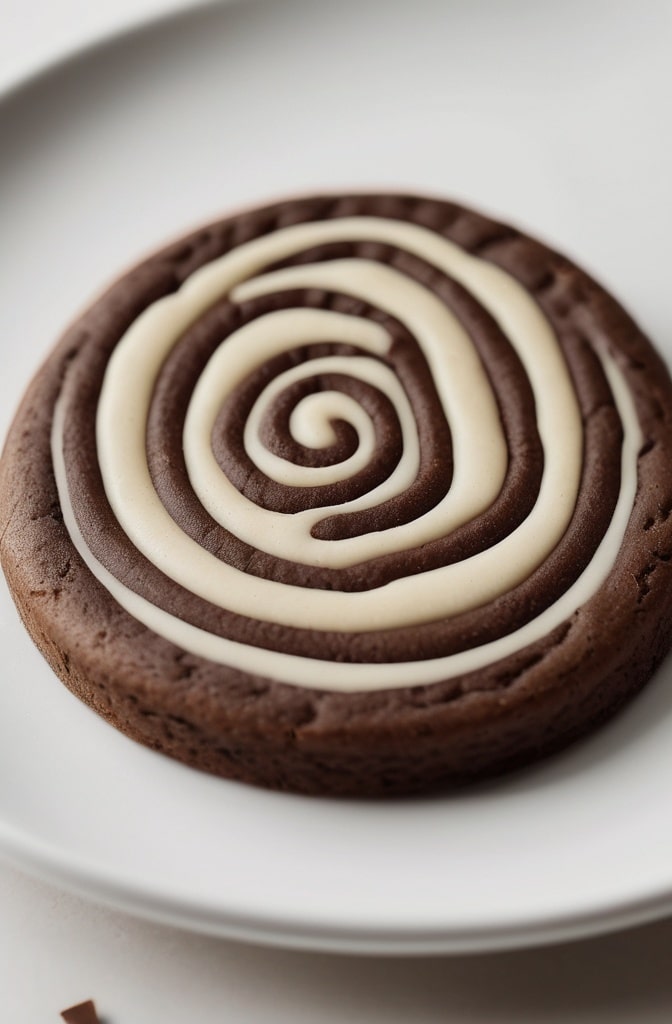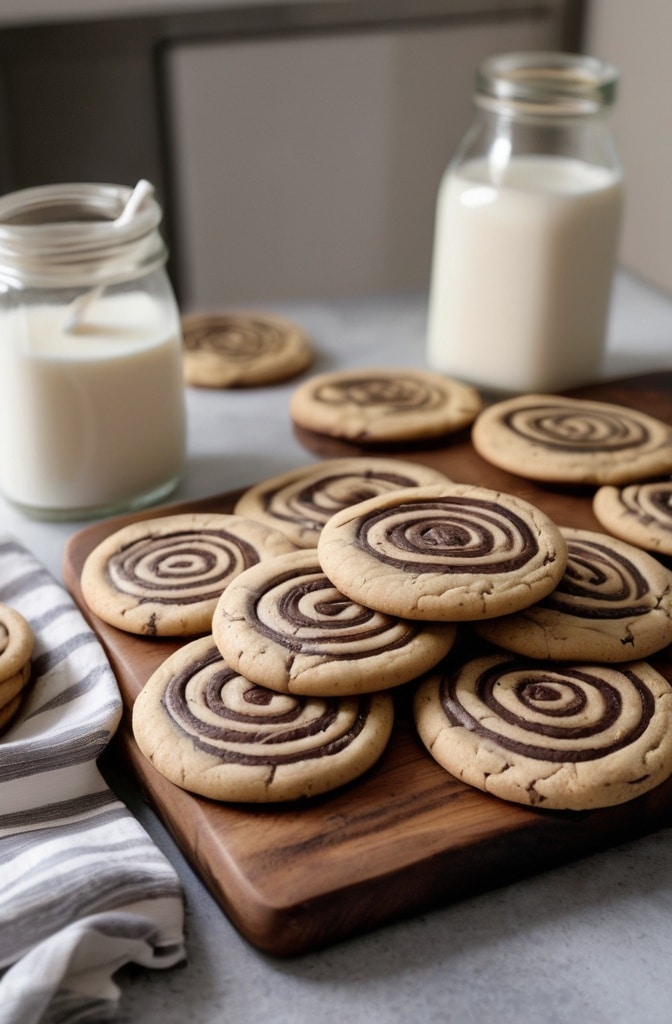Remember your first time seeing a perfectly made zebra cookie? Those hypnotic spirals of chocolate and vanilla dancing together in perfect harmony, practically begging to be devoured. I certainly do. My grandmother used to make them for special occasions, and just thinking about her Zebra Cookies Chocolate Vanilla Recipe brings back a flood of warm memories.
The anticipation of watching her reveal that first slice those perfect stripes exposed like edible art—still makes me smile. There’s something almost magical about how such simple ingredients in a zebra cookies chocolate vanilla recipe can transform into something so visually striking.
But zebra cookies ain’t just about looks. These cookies represent the perfect marriage of two classic flavors that have stood the test of time, offering a delightful textural experience that few other cookies can match.
What Makes Zebra Cookies Special?
Zebra cookies (sometimes called marble cookies or striped cookies) stand out from the cookie crowd for several reasons. First off, they’re visually stunning—those alternating layers of chocolate and vanilla create an impressive pattern that looks way more complicated than it actually is. Trust me on this.
The beauty of zebra cookies lies in their dual personality. Each bite delivers both rich chocolate intensity and mellow vanilla sweetness, creating a balanced flavor profile that appeals to practically everyone. Unlike many decorative cookies that sacrifice taste for appearance, these deliver on both fronts.
The technique used to create the distinctive pattern is surprisingly straightforward but offers endless opportunity for creative expression. You can adjust the thickness of your layers, play with the colors, or even introduce new flavors to create your own signature version.
Ingredients & Substitutions
For the Vanilla Dough:
- 2½ cups all-purpose flour (310g)
- ½ teaspoon baking powder
- ¼ teaspoon salt
- 1 cup unsalted butter, softened (227g)
- 1 cup granulated sugar (200g)
- 1 large egg, room temperature
- 2 teaspoons pure vanilla extract
- 1 tablespoon whole milk
For the Chocolate Dough:
- ¼ cup unsweetened cocoa powder (25g)
- 1 tablespoon whole milk
- ½ teaspoon espresso powder (optional, intensifies chocolate flavor)
The foundation of any good zebra cookie starts with quality ingredients. Vanilla extract—not the imitation stuff—makes a massive difference here. If your budget allows, Madagascar bourbon vanilla extract offers complex, floral notes that elevate the entire cookie.
For the butter, European-style with higher butterfat content will yield a richer, more tender cookie. If you’ve only got salted butter on hand, just reduce the added salt to a pinch.
Can’t do regular flour? A good quality cup-for-cup gluten-free flour blend works surprisingly well in this recipe, though the texture might be slightly more crumbly. Almond flour is NOT recommended as a straight substitute—it’ll change the consistency too dramatically.
For dairy-free bakers, plant-based butter sticks (not tub spreads) can substitute, but you’ll loose some of that rich mouthfeel. Coconut oil (in solid form) works in a pinch but will impart a slight coconut flavor.
The cocoa powder deserves special attention. Dutch-processed cocoa creates a darker, more intense chocolate layer with less acidity, while natural cocoa powder gives a more robust, fruity chocolate flavor. Either works, but don’t mix them up within the same batch.
Step-by-Step Instructions

Preparing the Base Dough:
- In a medium bowl, whisk together flour, baking powder, and salt. Set this aside—proper mixing at this stage prevents flour pockets in your final dough.
- In a large bowl or stand mixer fitted with the paddle attachment, cream the butter and sugar together until light and fluffy, about 3-4 minutes. Don’t rush this step! This creates air pockets that give your cookies their perfect texture.
- Add the egg and vanilla extract, beating until fully incorporated. The mixture might look slightly curdled at first, but it’ll come together.
- Gradually add the flour mixture on low speed, mixing just until combined. Overmixing activates the gluten and will make your cookies tough—nobody wants that.
- Add the tablespoon of milk and mix until the dough comes together. It should be soft but not sticky.
Dividing and Flavoring:
- Weigh your dough and divide it equally into two portions. If you don’t have a scale, just eyeball it—it doesn’t have to be perfect.
- Return one half to the mixing bowl. Add the cocoa powder, additional tablespoon of milk, and espresso powder (if using). Mix until uniform in color with no streaks. The extra milk compensates for the drying effect of the cocoa powder.
- Wrap both doughs separately in plastic wrap and refrigerate for 30 minutes. This brief chilling makes the dough easier to handle without making it too firm.
Creating the Zebra Pattern:
- Line a 9×5-inch loaf pan with parchment paper, leaving overhang on the long sides for easy removal later.
- Take a tablespoon of vanilla dough (about 25g) and roll it into a ball. Flatten it slightly and place it in the center of the prepared pan. Do the same with the chocolate dough, placing it directly on top.
- Continue alternating tablespoons of vanilla and chocolate dough, always placing in the center. Each new addition will push the previous layers outward, creating concentric rings. I like to use a cookie scoop for consistency.
- Once all dough is used, press down gently to remove any air pockets. Don’t press too hard—just enough to ensure the layers adhere.
- Cover the pan with plastic wrap and refrigerate for at least 2 hours or overnight. Patience here is crucial—skimp on chilling time and you’ll loose those sharp, defined stripes.
Baking:
- Preheat your oven to 350°F (175°C). Line baking sheets with parchment paper.
- Remove the dough log from the refrigerator and lift it out of the pan using the parchment overhang.
- With a sharp knife (not serrated), cut crosswise into ¼-inch slices. Each slice reveals the beautiful zebra pattern. If the dough crumbles while cutting, let it warm slightly for 5 minutes.
- Place slices about 1 inch apart on prepared baking sheets. These don’t spread much, so you can place them fairly close together.
- Bake for 10-12 minutes until the edges are just set but not browned. The cookies should still be soft in the center.
- Allow cookies to cool on the baking sheet for 5 minutes before transferring to a wire rack to cool completely.
A common mistake is overbaking—these cookies should remain pale with just a hint of golden color around the edges. If you wait until they look “done,” they’ll end up dry and crumbly. Remember, they continue cooking slightly on the hot baking sheet after removal from the oven.
Cooking Techniques & Science
The science behind those beautiful zebra patterns is fascinating. When you layer the doughs concentrically and then slice across them, you’re essentially creating a cross-section view of the stack. This technique—derived from traditional Japanese nerikiri confectionery methods—creates the illusion of stripes without any special tools.
Temperature control plays a crucial role in zebra cookie success. The initial chilling firms the dough just enough to maintain layer definition without making it too hard to work with. The longer refrigeration before slicing is absolutely essential—it allows the butter to resolidify completely, which helps maintain those clean, sharp edges when slicing.

The difference in ingredients between the vanilla and chocolate portions creates slight variations in how they bake. The cocoa powder in the chocolate dough absorbs moisture and contains fat, making that portion slightly denser and less prone to spreading. This subtle difference actually helps maintain the distinct boundary between the colors during baking.
To achieve the sharpest pattern definition, many professional pastry chefs freeze the assembled dough log for about 15 minutes just before slicing. A partially frozen log cuts more cleanly, preserving those crisp edges when revealed.
The baking powder in this recipe is minimal by design. Too much leavening would cause the cookies to rise and spread excessively, distorting those beautiful rings. We want just enough lift to prevent denseness without compromising the pattern.
Variations and Creative Twists
Tired of the classic chocolate-vanilla combo? Try these creative variations:
- Matcha Zebra: Replace the cocoa portion with 2 tablespoons of high-quality matcha powder for a stunning green and white pattern with sophisticated flavor.
- Citrus Zing: Add 1 tablespoon of fresh orange or lemon zest to the vanilla portion for a bright, aromatic twist.
- Spiced Chocolate: Enhance the chocolate dough with ½ teaspoon of ground cinnamon, a pinch of cayenne, and a drop of almond extract for a Mexican chocolate inspired flavor.
- Red Velvet Zebra: Replace the cocoa with 3 tablespoons of red velvet cake mix and 1 tablespoon of cocoa powder for a festive holiday variation.
- Cookies & Cream: Fold finely crushed Oreo cookie crumbs into the vanilla portion for a cookies-and-cream inspired twist.
For a particularly impressive presentation, try making a triple-stripe version by dividing your base dough into three portions instead of two. Color one with cocoa, leave one vanilla, and tint the third with food coloring or fruit powder for a stunning rainbow effect.
Serving & Pairing Suggestions
Zebra cookies make a stunning addition to any cookie platter, especially when arranged in a spiral pattern that showcases their distinctive stripes. For an elegant presentation, try partially dipping them in tempered dark chocolate and sprinkling with gold dust or finely chopped nuts.
These cookies pair beautifully with both hot and cold beverages. A glass of cold milk brings out the nostalgic cookie jar quality, while an espresso or americano complements the chocolate notes perfectly. For afternoon tea, try serving with Earl Grey or a vanilla rooibos.
For dessert platings, arrange three zebra cookies alongside a quenelle of premium vanilla ice cream, drizzled with warm chocolate sauce. The temperature contrast between the crisp cookie and cold ice cream creates a delightful sensory experience.
Want to gift these impressive treats? Stack them in a clear cellophane bag tied with black and white striped ribbon to emphasize the zebra theme. They maintain their pattern definition for up to two weeks when properly stored, making them excellent make-ahead gifts.
Storage and Make-Ahead Tips
The beauty of zebra cookies lies partly in their convenience. The dough logs can be prepared up to three days in advance and kept refrigerated, or frozen for up to three months. If freezing, wrap the log first in plastic wrap, then in aluminum foil to prevent freezer burn.
When ready to bake from frozen, let the log thaw in the refrigerator overnight before slicing and baking as directed. Alternatively, you can slice the cookies while the log is still partially frozen—it actually makes for cleaner cuts.
Baked cookies store wonderfully in an airtight container at room temperature for up to a week. Separate layers with parchment paper to protect the patterns. For longer storage, freeze baked cookies for up to three months. Allow them to thaw at room temperature before serving.
The raw dough itself can also be frozen in pre-sliced rounds. Arrange the slices on a parchment-lined baking sheet, freeze until solid, then transfer to a freezer bag. This method allows you to bake just a few fresh cookies whenever the craving strikes.
Troubleshooting Common Issues
Problem: Dough is too crumbly and won’t hold together. Solution: The most common cause is measuring flour by volume rather than weight, which often leads to using too much. Add ½ tablespoon of milk at a time until the dough just comes together. Next time, try the “spoon and level” method for measuring flour.
Problem: Layers aren’t distinct after baking. Solution: Insufficient chilling is usually the culprit. Make sure to refrigerate the assembled log for at least 2 hours, preferably 4 hours or overnight. Also, check that your knife is very sharp when slicing.
Problem: Cookies spread too much, distorting the pattern. Solution: Your butter might’ve been too warm, or the baking sheets were warm from a previous batch. Make sure to start with properly chilled dough and cool baking sheets.
Problem: Chocolate dough is too dry compared to vanilla. Solution: The cocoa powder absorbs moisture. Be sure to add that extra tablespoon of milk to the chocolate portion, and don’t over-measure the cocoa.
Problem: Centers are raw while edges are overdone. Solution: Your oven temperature may be running hot. Try reducing the temperature by 25°F and using an oven thermometer to verify accuracy. Also, rotate baking sheets halfway through baking.
Conclusion
Zebra cookies represent that perfect intersection of visual appeal and delicious flavor that we’re all searching for in our baking. The technique—while impressive-looking—is accessible to bakers of all skill levels, making these cookies a wonderful project for both beginners and experienced bakers looking to add something special to their repertoire.
What I love most about zebra cookies is their versatility. Whether you stick with the classic chocolate-vanilla combination or experiment with creative flavor variations, the distinctive striped pattern always elicits smiles and appreciation from those lucky enough to enjoy them.
Mastering these cookies teaches valuable lessons about dough consistency, temperature control, and the importance of patience in baking. Once you’ve got the basic technique down, you’ll find yourself applying these principles to other baking projects with newfound confidence.
So go ahead—impress your friends, family, or customers with these showstopping treats. Just don’t be surprised when they disappear from the cookie plate faster than any others!
FAQs About Zebra Cookies Chocolate Vanilla Recipe
Can I make the dough ahead of time?
Absolutely! The dough logs can be refrigerated for up to 3 days or frozen for up to 3 months. If frozen, thaw overnight in the refrigerator before slicing and baking.
Why aren’t my stripes as defined as they should be?
Sharp stripes depend on proper chilling time and clean cutting. Make sure your dough is thoroughly chilled (at least 2 hours) and use a very sharp knife. Some bakers even use dental floss for ultra-clean cuts!
Can I use food coloring instead of cocoa powder for colored stripes?
Yes! Gel food coloring works best as it won’t add additional liquid to the dough. Add it to the vanilla portion after dividing the base dough. Start with a small amount and increase until you reach your desired color intensity.
My cookies spread too much and lost their pattern. What went wrong?
Most likely, either your butter was too warm or you didn’t chill the dough long enough. Make sure to follow the chilling times precisely, and consider putting the sliced cookies back in the refrigerator for 10 minutes before baking if your kitchen is warm.
How do I get perfectly round cookies?
If your log becomes slightly flattened during refrigeration (which is common), roll it gently on the counter immediately after removing it from the refrigerator to restore its circular shape before slicing.

